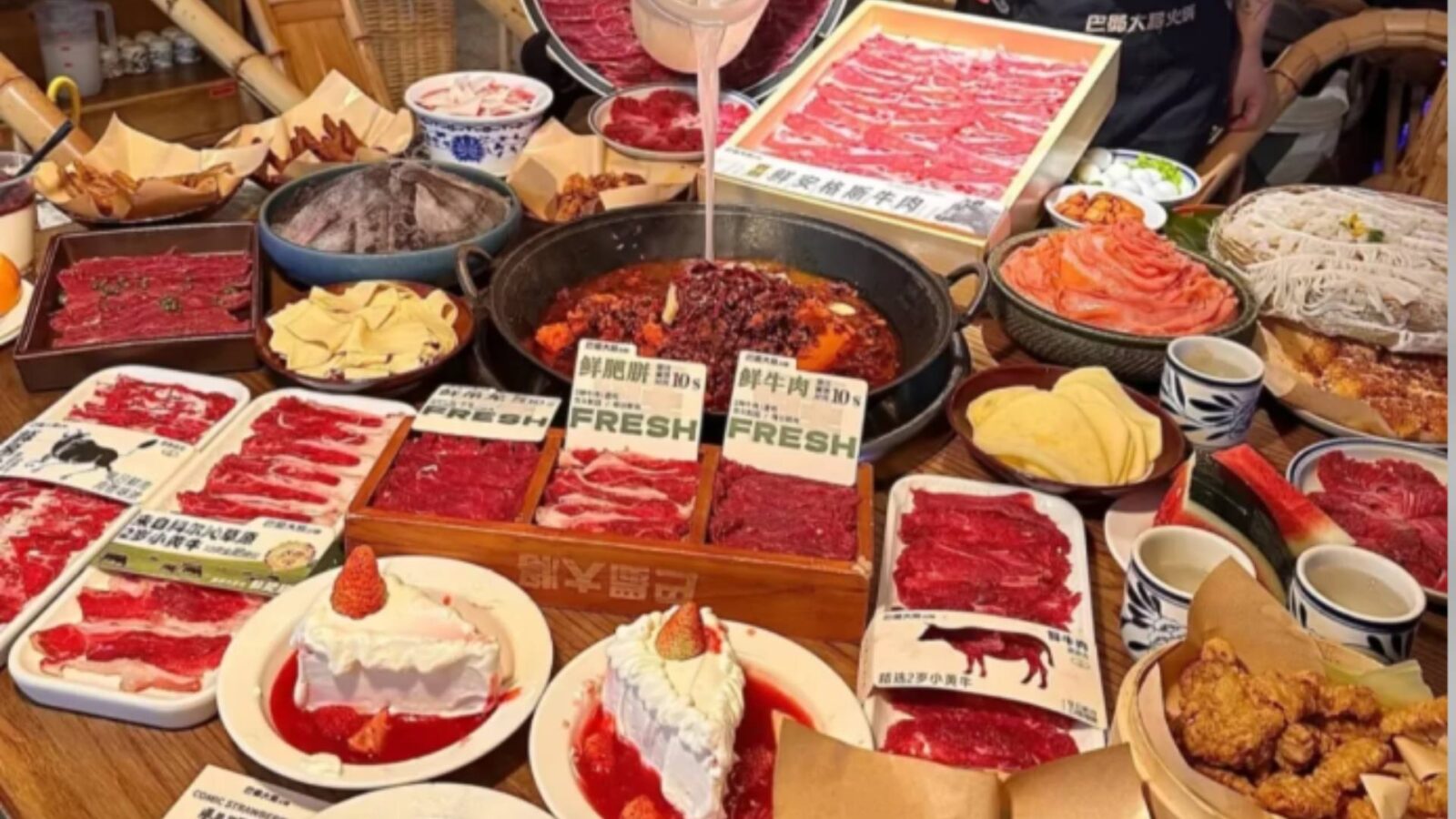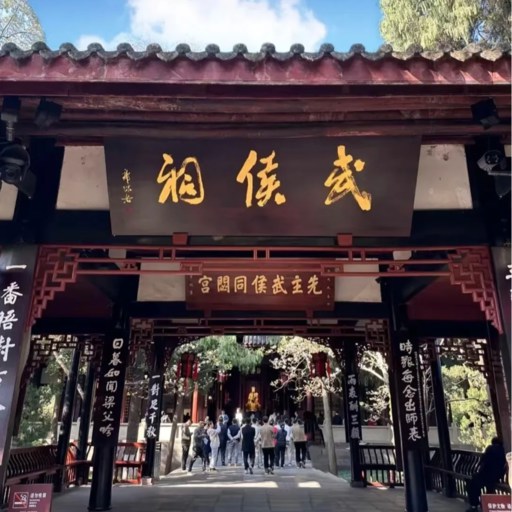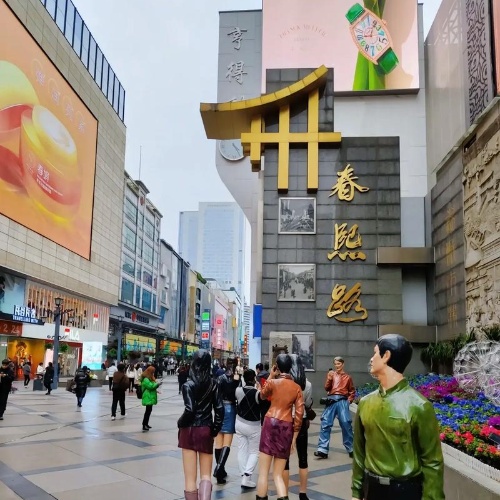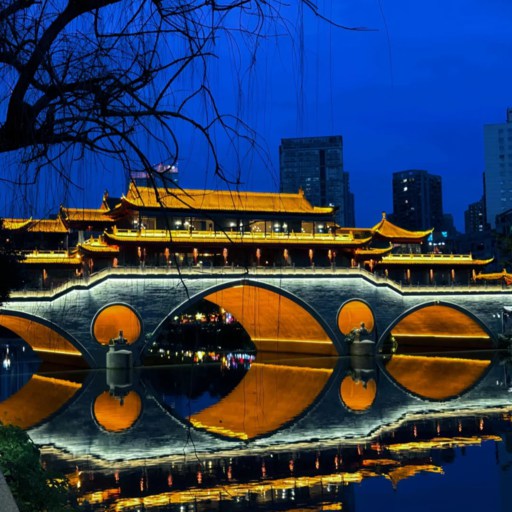
Jiuyan Qiao
Jiuyan Bridge is located along the Jinjiang River, at the point where Chengdu is undressing and beginning to breathe. It is not at all extraordinary by day--a white archway above still water, yet in the evening, when the lamps of hundreds of bars play across the river, it is a different question. There are also places that feel almost intimate and there are some with three tables and slow playlist, and there are places that grind with bass and laughter overflowing on the walkway. The combination is sloppy, human and all Chengdu.
It is named after the four-hundred year old Jiuyan Bridge that features nine stone arches, constructed in both the Ming and Qing style. People refer to the entire area as Jiuyanqiao Bar Street and it is where the easy flow of the city is realized. You may get hold of a drink, and talk till midnight, or lean over the railing and blur neon on the water. You could get whatever you came to find in Chengdu but chances are that it will pass through here.
Quick Facts about Jiuyan Bridge
| Location | Wuhou District, Chengdu — along Jinjiang River, near Sichuan University |
| Built / Origin | First constructed in 1593 (Ming Dynasty); rebuilt as a steel-frame bridge in 1988 |
| Why “Jiuyan” | Named for its nine arched “eyes” that reflect beautifully on the river at night |
| Highlight | Daytime riverside strolls and nighttime bar street with live music and open-air terraces |
| How to Get There | Metro Line 2 → Niuwangmiao Station (Exit B), 8-minute walk; buses 56 / 82 / 112 stop nearby |
| Best Time to Visit | Late afternoon to evening for golden light and neon reflections |
| Entry Fee | Free to enter; bars and cafés average ¥60–120 per person |
| Local Tip | Weekday evenings are calmer for photos; weekends get crowded after 9 p.m. |
What is Jiuyan Bridge? (What to Expect)
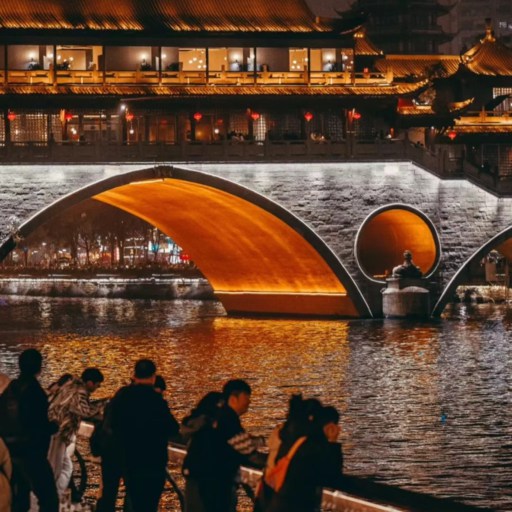
Lake and Jiuyan Bridge
Jiuyan Bridge shuts it down where the Jinjiang and Nanhe Rivers converge, a few blocks away from Sichuan University and the green boughs of Wuhou District. By day, it’s almost polite — buses scoot by, students cross with iced coffee in hand and a breeze off the river brings the whiff of wet stone and jasmine. But wait until nighttime — that’s when Jiuyan Bridge takes on a different tone. The nine arches begin to capture little pings of orange light, and the water beneath mirrors them so precisely that it begins to feel as if the bridge is floating.
On the railing, you can make out the shuffle of feet and catch the low hum of music emanating from waterside bars. Somewhere behind you a grill sizzles, and someone laughs too loudly. The sounds are not discordant; they coalesce, into what locals call “the rhythm of Chengdu nights.” I leaned on the stone and watched the reflections waver in place with the pull of water, realizing that Jiuyan Bridge is not famous because it’s old — it’s because this entire place feels alive.
The locals name it Jiuyan Qiao bar street, but that hardly does it justice. This is not only a bridge; it’s a district that wakes as most other parts of the city sleep. No gates, no tickets — just lights, chatter and an open invitation to walk, stop and maybe stay a little longer than you intended. There are some hangouts in Chengdu that, well, you hang out at; Jiuyan Bridge is one of the kind you return to when your back’s turned.
The History of Jiuyan Bridge – Nine “Eyes”, Many Stories
Origin & Name (“Nine Eyes” Explained)
Long before Jiuyan Bridge became Chengdu’s nightlife party magnet, it was just a crossing for merchants and ferrymen. Back in the day, locals called it “Hongji Bridge” or later “Fujian Bridge,” depending on who you asked and which dynasty was running things that year. Originally completed as a solid, arched stone bridge in 1593 during the Ming Dynasty, the bridge was designed to withstand seasonal floods that inundated this low-lying city. It took its nickname — Jiuyan, or “Nine Eyes” — from the nine arches below, each would make a perfect circle under which boats could sail up and down the Jinjiang River. At night, when those arches were reflected in the still water of the stream, it looked like eighteen glowing eyes winking from below the city.
Elders here say that cargo boats used to dock beneath those arches and line them up from end to end, carrying rice and silk toward the city markets. In ancient maps of Chengdu, Jiuyan Bridge designated the southern entry gate of river transportation, one of the most bustling hubs across the Fu and Jin rivers. You can still spot remnants of those days in the brick paths along riverbanks — stones smoothed by carts that are no longer driven. Now, standing here, it’s odd to think that the same arches that once reverberated with oars and shouts now throb with music and laughter.
Modern Transformation & Urban Role
The current Jiuyan Bridge, a steel-frame and concrete representation of the nine-arch form dating to 1988 but widened for cars and pedestrians. The water traffic disappeared, but the bridge did not become defunct — it found a new purpose. The former water-transit hub emerged, following a decade-long dig and 14 years of construction, as the social artery of contemporary Chengdu — linking the university crowd to creative bars and cafes in the city that would soon make Jiuyan Qiao street famous.
When you’re there by jiuyan bridge, you can feel that alchemy of memory and motion. On its promenade along the bay, office workers take a break, painters set up easels and street musicians perform alongside old railings. What started out as a local hangout by the 2000s had become one of Chengdu’s signature nightscapes, almost always paired with Anshun Bridge just downstream. Today, jiuyan bridge is more than an icon to the past — it’s a bridge between old Chengdu’s watery ways and the city’s restless pace, a living testament that history here never truly sleeps.
What to See & Do at Jiuyan Bridge
Daytime Stroll & Riverside Calm
At midday, Jiuyan Bridge seems to be still half asleep. The Jinjiang River glides along, snaring the light like brushed silk and down on toasty old stone paths. Locals sit on bamboo chairs sipping tea as kids chase pigeons nearby, while vendors grill skewers rich with peppercorn and soy aromas. As Deep China Travel notes, many visitors skip daytime visits, but that’s a mistake — this is one of the few downtown Chengdu spots where the river outvoices the traffic.
For the best photo, walk to the opposite bank near Anshun Bridge, where you can see Jiuyan Bridge with its nine arches framed by trees and skyline. Near sunset, the water mirrors the bridge so perfectly that real and reflection seem one. The air softens, bicycle bells jingle, and chatter from nearby teahouses drifts across — reminding you that nobody should ever rush through Chengdu.
Nightlife – Bar Street & Neon Lights
After the sun goes down, Jiuyan Bridge bar street comes alive in color. Music oozes from every doorway — jazz, techno, some mad thing between the two — and neon signs bounce over the river like liquid glass. Here, you’ll find upward of a hundred bars, ranging from rooftop lounges to riverfront patios to dark dives offering their own takes on “Chengdu chill.” I recall the night air nudging past, a DJ set kicking off and laughter rolling over the bridge. “This is where the city forgets time,” people say.
If you’re curious about where else to feel this kind of energy, check out other nightlife spots that rival Jiuyan Bridge — you might find a few that surprise you.
Prices depend on the vibe: a riverside seafood bar hovers around ¥60 a person; cocktail lounges can creep up to ¥120. If you like conversation, snare a spot on the quieter terraces of the eastern side; if you want noise and somewhere to dance (Friday nights are for dancing), be guided by the throng heading towards the central strip. Don’t hurry either way — this isn’t a place you check off a list; it’s one that sweeps over you.
Nearby Hidden Gems
After you’ve had your fill of the lights, stroll along the river. A 10-minute walk in the other direction, Anshun Bridge (安顺廊桥) looms, its covered walkway cast in gold across water. The nearby old Sichuan University campus is shaded and home to century-old gingko trees, a great spot for a leisurely promenade. Narrow alleys like Teahouse Lane are the location of tiny cafés where elderly locals come to play mahjong. Street food stalls on Wangping Street remain open when the sun goes down, hawking spicy noodles and sugar-covered hawthorns for just a few yuan. There are two sides of Chengdu that day and night reveal, in this respect not one but two cities that together help jiuyan bridge feel like the city’s true pulse, according to CITS China 6 Travel Service.
How to Get to Jiuyan Bridge & Visitor Practicalities
Transport Options
You can find Jiuyan Bridge without speaking Chinese, though it’s still pleasantly out of the way. The easiest way is by metro — board Line 2 or Line 3/8, exit at Niuwangmiao Station (牛王庙站) and walk on foot for roughly eight minutes along the Jinjiang River bend. Signs along the street by the exit already say “九眼桥 / Jiuyan Qiao,” because that particular kind of Chinese actually uses some English characters sometimes (with confusing, but not disastrously so.) Deep China Travel says this is the most efficient route to take for visitors originating from central hotels or Tianfu Square in Chengdu.
If the bus is more your thing, buses 56 and 82 (among others) stop near the bridge—look for stations that say “Jiuyan Bridge West,” “Jiuyan Bridge North” or “Jiuyan Bridge South.” Local buses are reliable, but have scant English signage, so keep a translation app at the ready. A Didi or taxi from the likes of Chunxi Road or Taikoo Li will take about 20–30 minutes and cost around ¥18–25, subject to traffic. On the debarkation side, some drivers might inquire “去九眼桥?” — when they do, simply nod your head.
Visiting Tips & Best Time
Get to jiuyan bridge around 5 p.m. when the sun has gone soft and the air has cooled down. Before the neon comes on, you’ll nab the golden reflection of those arches. Locals like to sit by the river with a drink as the lights flick on — this “in-between hour” is when it’s most photogenic. For photographs, try to hit sunset but up until dusk; the light reflecting off of the water will give you that mirror look photographers so adore.
There is no entrance fee, and both banks are free to walk along. Bars and cafés tend to price dishes individually, think about ¥60–120 per person depending on the venue. And as China Job City points out, weekends quickly fill up, if you like to have room. And, sure, the music gets louder as night presses past 10 p.m., especially near Jiuyan Qiao Bar Street — either join in or walk a bit farther down the riverbank for a calmer scene.
If you want to pair the night walk with a taste of the city’s spice, see where locals actually eat on this Chengdu food crawl — it’ll make your Jiuyan Bridge evening twice as good.
Useful Tips for Foreign Visitors
You won’t need much Mandarin, if any beyond “ni hao” and “xie xie,” around Jiuyan Bridge. Most of the bars here have English or bilingual menus, and younger staff members are able to handle a basic conversation — ordering drinks or requesting a seat is hardly ever an issue. Still, it’s useful to know a little bit of Chinese — such as “bu tai la” (not too spicy) or “mai dan” (bill, please). If you get stuck, open your phone’s translation app; locals are accustomed to tourists bumbling around and tend to smile through the confusion.
Crowds arrive quickly after 8 p.m., especially around Jiuyan Qiao Bar Street, so keep your wits about you. Chengdu is generally a safe city, but like any bustling hub of nightlife, just keep an eye on your bag and don’t walk around alone after midnight. The river walkway is well-lit, but the side alleys hush up soon after the music does: Don’t stray too long from earshot. Police presence is strong, and it feels safe even on festival weekends.
Budget-wise, Trip. com reviews including drink and a snack ¥60 on average, but full dinners at the riverside restaurants go for ¥120–150 depending on style. Vendors on the street sell skewers or noodles for only ¥10–20 (if you’re bar-hopping). Breezes can kick in at night by the river, so a light jacket is a good idea. The air has an ozone-laden dampness to it, that chill on the back of your neck which smells faintly like rain; in summer especially, that thing which reminds you why evenings at jiuyan bridge feel so alive.
FAQ about Jiuyan Bridge
Q: Is jiuyan bridge worth visiting?
Yes. Jiuyan Bridge isn’t just a nightlife area; it’s a part of the pace of life in Chengdu. You can stroll along the riverside by day, watch the sunset from its arches and see how the city lights dance on Jinjiang. And even if you do not drink, the bridge’s blend of music, food and tranquillity ensures an unforgettable experience.
Q: When is the best time to take photos of jiuyan bridge?
The golden hour — from about 5:30 to 7 p.m. — is ideal. As daylight bathes the arches, the neon signs stir. On the other side of the river, reflections double in the water, offering jiuyan bridge that photographed “nine eyes glowing” effect. If you are going to be taking night shots, bring a tripod.
Q: How do I go to jiuyan bridge by metro?
Take Metro Line 2 or Line 3/8 to Niuwangmiao (牛王庙) Station, at Exit B, then walk about eight minutes along the Jinjiang River. There are signs to jiuyan bridge as you exit; follow the crowd to the sound of music and the blast of neon.
Q: Is jiuyan bridge safe at night?
Generally, yes. There are plenty of well-policed and friendly nightspots in Chengdu. Jiuyan bridge, however, gets crowded after 9 p.m., so keep your bag close and don’t wander into dark alleys: Use Didi or taxis if you’re out late. You can see cop booths outside of bars in the entrances.
Q: What is the difference between jiuyan bridge and anshun bridge?
Jiuyan Bridge is outdoor, louder and more filled with contemporary bars. Anshun Bridge, just downstream, is enclosed — a landmark bridge from the past turned into high-end dining. Think of Jiuyan as social and young, Anshun as serene with views lit by candlelight. Both are a hot stop for many people on the same evening.
Q: Do I need to drink or go in bars to have fun at jiuyan bridge?
Not at all. Jiuyan bridge is free and nice to walk across. You can pick up street snacks, hear live music from afar or sit by the river and watch reflections. Many visitors come just for the views and people-watching, avoiding alcohol altogether.
Q: Are there family-friendly activities at jiuyan bridge area?
Yes, particularly early in the evening before crowds swarm. The riverside boardwalk consists of open space for strolls, small dessert cafés and snack stands. Most families come before 8 p.m. To enjoy the lights and street performances without having to deal with the bar noise.
Q: What nearby attractions can I pair with visiting jiuyan bridge?
Mix jiuyan bridge to Anshun Bridge, Wangping Street night snacks or the old Sichuan University campus. All are within a 15-minute walk. If you have more time, escape the city’s nightlife for a half-day at Wenshu Monastery or Dujiangyan Scenic Area.
